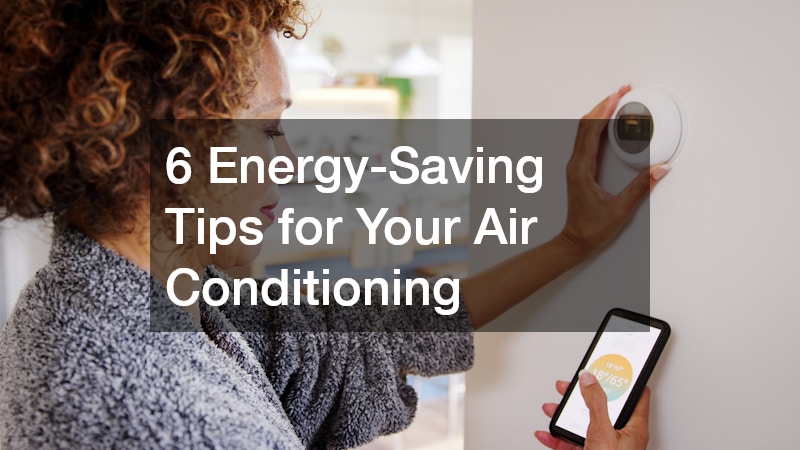With Australia’s famously hot summers and increasingly variable weather, air conditioning has become an essential fixture in many homes. However, the comfort it provides can come with a significant cost, both financially and environmentally. This is especially true as more Australians turn to cooling systems to cope with rising temperatures caused by climate change, pushing household energy usage to unprecedented levels.
Energy consumption spikes during the warmer months, often leading to high electricity bills and unnecessary carbon emissions. Fortunately, there are practical strategies you can adopt to maintain indoor comfort without straining your wallet or the environment. These six energy-saving tips will help you get the most out of your air conditioning while keeping energy use in check.
1. Optimise Your Thermostat Settings
Setting your thermostat to the right temperature is one of the most effective ways to reduce energy consumption. During summer, aim for a temperature around 24 to 26 degrees Celsius when you’re at home. Each degree cooler can increase your energy usage by up to 10 per cent, so even a small adjustment makes a significant difference over time.
When you’re not home, increase the temperature or turn the system off altogether. If your system has a programmable thermostat, take advantage of its scheduling functions to automate temperature changes based on your daily routine. This approach minimises the strain on your air conditioning and avoids unnecessary energy usage when it’s not needed.
2. Ensure Proper Insulation & Sealing
Cooling your home effectively relies on more than just a quality air conditioning unit. Poor insulation and air leaks can allow cool air to escape and hot air to enter, forcing your system to work harder. Start by checking for drafts around doors, windows and any gaps in the building envelope.
Weather stripping and door seals are simple, cost-effective fixes that can dramatically improve your home’s energy efficiency. Also, make sure your ceiling, walls and floors are properly insulated. Well-insulated homes maintain a stable indoor temperature, reducing the frequency and duration of cooling cycles. Over time, these enhancements lead to substantial energy and cost savings.
3. Clean & Maintain Your System Regularly
An air conditioning unit operating at peak performance consumes less energy and provides more effective cooling. Regular maintenance is key to achieving this. Clean or replace filters every one to three months, depending on usage and environmental factors such as dust and pet hair.
A clogged filter restricts airflow, causing the system to work harder and consume more energy. It’s also essential to have a professional technician inspect the unit annually. They can check for refrigerant levels, inspect electrical components and ensure the coils are clean. Preventative maintenance not only improves energy efficiency but also extends the life of your system.
4. Use Ceiling Fans to Support Cooling
Ceiling fans can significantly enhance the efficiency of your air conditioning by circulating cool air more evenly throughout your home. When used in conjunction with your cooling system, fans create a wind-chill effect that makes the room feel cooler than it actually is. This means you can raise the thermostat setting by a few degrees without sacrificing comfort.
Make sure your ceiling fans are set to rotate counterclockwise in summer, pushing cool air downward. This technique reduces the burden on your air conditioning and contributes to lower energy consumption overall.
5. Limit Heat Sources During the Day
Appliances and lighting can generate unwanted heat, particularly during the hottest parts of the day. Cooking with ovens or stovetops, using clothes dryers or operating high-powered electronics can raise the indoor temperature, making your air conditioning work harder. To reduce this effect, consider preparing cold meals or using a microwave, which emits less heat.
Delay laundry and dishwashing tasks until the evening and switch to energy-efficient lighting options like LEDs that produce minimal heat. Taking steps to limit indoor heat generation not only keeps your living space cooler but also reduces your energy bills.
6. Shade & Cover Windows Effectively
Sunlight streaming through windows can significantly heat up your home, especially if they are large or face west. Using curtains, blinds or external shading devices can block out direct sunlight and help maintain a cooler indoor temperature. Thermal or blockout curtains are particularly effective at insulating your home against heat.
Additionally, planting trees or installing awnings outside sun-facing windows can provide natural shade. Window films are another solution that reduces heat gain without compromising natural light. By reducing solar heat gain, you lessen the demand on your air conditioning system, leading to noticeable energy savings.
Stay Cool Without Wasting Energy
Saving energy while using air conditioning doesn’t require major sacrifices. With small changes to your habits and home environment, you can enjoy a cool, comfortable space without excessive power consumption. From adjusting thermostat settings and maintaining your system to sealing your home and reducing indoor heat sources, these simple yet effective strategies can make a big difference.
Not only will you lower your electricity bills, but you’ll also be contributing to a more sustainable future. By treating your air conditioning system as part of a broader energy-efficient plan, you ensure that comfort and cost-effectiveness go hand in hand.
.

